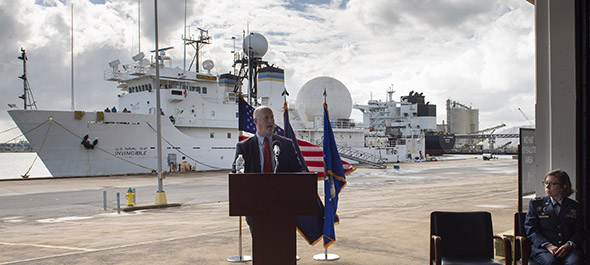Missile Range Instrument Ship USNS Invincible inactivated

Christopher Thayer, director of maritime operations for Military Sealift Command, delivers his keynote address during the Inactivation Ceremony of the U.S. Naval Ship Invincible (seen in background) at Cape Canaveral Space Force Station, Fla., December 15, 2021. At right is Col. Katharine Branson, commander of the Air Force Technical Applications Center, overseer of the Invincible's GRAY STAR ballistic missile radar system. U.S. Air Force photo
The following is excerpted from an article written by Susan Romano, U.S. Air Force Technical Application Center Public Affairs, and published in the February edition of Sealift, the official publication of Military Sealift Command.
With the white-hulled ship serving as the backdrop for the festivities, the Air Force Technical Applications Center and Military Sealift Command held a joint ceremony Dec. 15 to inactivate the missile range instrument ship USNS Invincible (T-AGM 24), at the U.S. Army Transportation Wharf, near Patrick Space Force Base, Florida, where AFTAC has its headquarters.
More than 150 people including Congressional staffers, U.S. Air Force general officers, senior MSC representatives and local elected officials were in attendance at Cape Canaveral Space Force Station to hear Christopher Thayer, Director of Maritime Operations for MSC, and Col. Katharine Branson, AFTAC's commander, speak about the importance of the ship and the role it played in national security for the past 35 years.
USNS Invincible housed the GRAY STAR radar system that provided unique, high quality, high resolution, multi-wavelength radar products used to monitor U.S. or foreign missile, space or weapons test events worldwide. Launched in 1986, and put into full operational service in 1987, Invincible's original mission was to patrol the seas looking for submarines using its sonar array.
The vessel was refitted in 2000 to support Joint Chiefs of Staff missions to monitor missile or weapons test events that could pose hazards or threats to air or surface navigation.
During its tenure, USNS Invincible deployed worldwide and AFTAC provided a company grade officer to serve as the ship's Mission Commander; whose responsibility was to ensure the platform's team successfully collected and delivered vital mission data.
The decision to inactivate the ship was based on higher headquarters requirements to balance sustainment costs, operational effectiveness, and the Department of Defense's pivot to strategic competition.
The DoD has a wide range of capabilities to support ballistic missile defense operations that continue to operate throughout the world today.
Maj. George Statzell V, a former Invincible mission commander and current officer-in-charge of AFTAC's Commander's Action Group, reflected on his time at the helm of the ship and the importance his crew played in national security.
"It takes a lot of coordination and teamwork to effectively employ an asset like GRAY STAR radar," said Statzell.
"The team aboard the Invincible made it work by focusing on the importance of the information they provided to national decision makers," He added, "It was a highlight of my career to serve as Invincible's MC. It's not often a junior officer gets the opportunity to command a naval mission, much less an Air Force officer. The job was demanding and had its own heightened level of stressors, but it was also a richly rewarding experience and one I'll carry with me for a lifetime."
During his remarks, Thayer commended the crew who "faithfully executed the mission."
"While these mariners operated in a threat environment, they answered the call to serve across all parts of the globe," he said, "bravely facing threats daily, from weather at sea to pirates and combatants, as they served their fellow Americans."
He thanked the thousands of crew members who maintained and sailed on Invincible over the years to enable other organizations to execute their complex mission set.
"The success of Invincible over these many years was due in great part to a series of highly effective partnerships between military commands and services, industry partners, and labor sources," Thayer said. "Whether civil service, uniformed military member or contractor, you contributed daily to the safety and security of our nation, and each one of you is a patriot."
USNS Invincible played a critical role in the U.S. National Security Strategy serving as a mobile tracking platform for recording data on missiles and satellites that were typically out of range of established land stations. During its time abroad, Invincible collected data on 73 different systems in its primary area of responsibility, the Middle East, providing the nation's most senior decision makers with technical measurements to monitor nuclear treaty compliance.
"I was struck by the way Mr. Thayer categorized today's event," Branson said during her remarks. "It's not so much the end of the line for Invincible, but a moment of transition. We must be able to adapt and respond to the ever-changing global environment to make us a strong, more efficient and successful force."
Branson congratulated the Airmen and all the mission partners for a job "exceedingly well done.
"Please accept my gratitude for your 'high-seas expertise' and willingness to get the job done. I am incredibly proud of you, and I look forward to what our maritime future has in store for us," he said.
It will take approximately seven months to fully inactivate the ship, with plans to re-purpose it into a training vessel or stored as part of the National Defense Reserve Fleet. The radar system will be re-purposed by the Air Force Research Laboratory to conduct testing and evaluation of advanced radar technologies.
